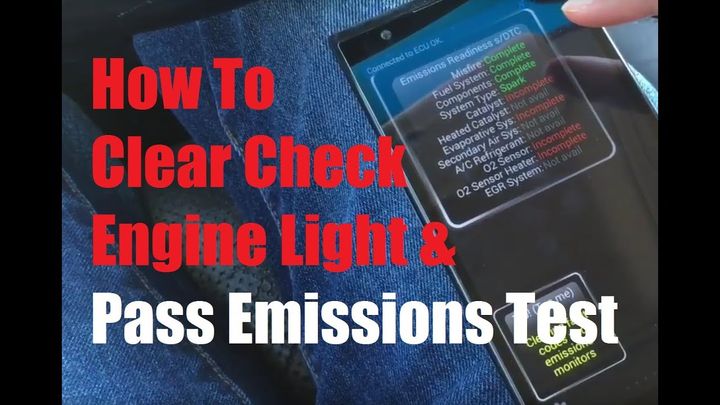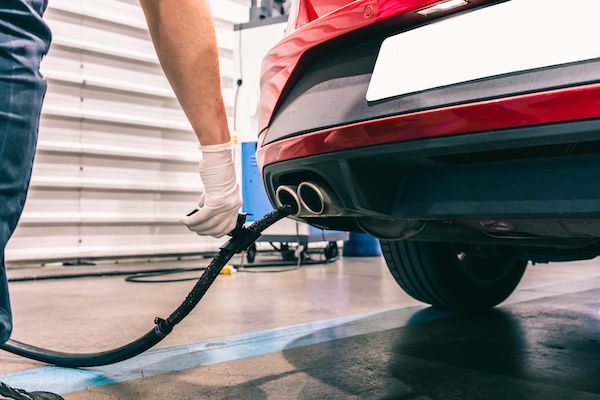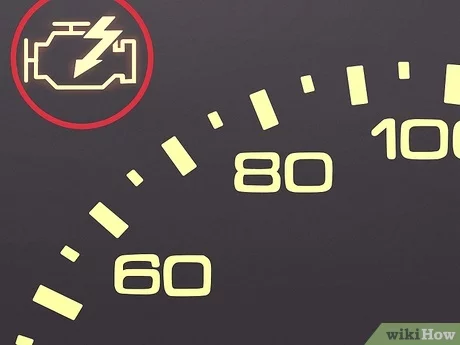


Emission tests, also known as smog checks, are mandatory inspections required in many states and regions to ensure vehicles meet the established emission standards and do not contribute excessively to air pollution. These tests are designed to identify vehicles with high emissions levels, allowing owners to address any issues through proper repairs or maintenance.

The check engine light, also known as the malfunction indicator lamp (MIL), is a warning signal that alerts you to potential issues within your vehicle's emission control system. It's important to note that the check engine light can illuminate for various reasons, ranging from minor to more significant problems. However, when it comes to emission tests, this light is a red flag that something might be amiss with your vehicle's emission control components.
Over the years, I've encountered several recurring issues that can cause emission test failures when the check engine light is on. Let's dive into some of the most common culprits:
| Component | Description |
|---|---|
| Faulty Oxygen (O2) Sensor | The oxygen sensor plays a crucial role in monitoring the air/fuel mixture in your engine. When this sensor malfunctions, it can lead to an improper fuel mixture, resulting in increased emissions and triggering the check engine light. |
| Catalytic Converter Issues | The catalytic converter is a vital component of your vehicle's emission control system, responsible for reducing harmful pollutants in the exhaust gases. If the catalytic converter becomes clogged or fails, it can no longer effectively convert these pollutants, leading to increased emission levels and a failed emission test. |
| Loose or Damaged Gas Cap | A loose or damaged gas cap allows fuel vapors to escape, triggering the emission system warning light. |
| Spark Plug or Ignition Coil Failure | Faulty spark plugs or ignition coils can cause misfires, leading to incomplete combustion and increased emissions. |
| Mass Airflow (MAF) Sensor Failure | The mass airflow (MAF) sensor measures the amount of air entering the engine, allowing the engine control unit to adjust the air/fuel mixture accordingly. A faulty MAF sensor can disrupt this balance, resulting in increased emissions and a check engine light. |
Now that we've covered some of the common culprits, let's dive into the diagnostic steps and repair procedures that can help you tackle this issue head-on.
One of the most powerful tools in a mechanic's arsenal is the OBD2 (On-Board Diagnostics) scanner. By connecting this device to your vehicle's diagnostic port, you can retrieve diagnostic trouble codes (DTCs) that provide valuable insights into the specific issue causing the check engine light. These codes will point you in the right direction, allowing you to pinpoint the root cause of the emission problem.

While the OBD2 scanner provides valuable data, a thorough visual inspection of the emission system components is also crucial. Look for any signs of damage, leaks, or wear that could contribute to the emission issue. This hands-on approach can often reveal clues that might not be apparent from the diagnostic codes alone.
In addition to the check engine light, pay attention to any other symptoms your vehicle may be exhibiting. Decreased fuel efficiency, rough idling, or increased engine noise can all be indicators of emission system issues. These symptoms can help you narrow down the potential causes and guide your repair efforts.
| Procedure | Description |
|---|---|
| Replace Faulty Components | Once you've identified the faulty component(s) through diagnostic codes, visual inspection, and symptom analysis, it's time to replace them. Whether it's an oxygen sensor, catalytic converter, spark plugs, ignition coils, or MAF sensor, replacing the defective parts is often the most effective solution to resolving emission issues and extinguishing the check engine light. |
| Tighten or Replace Gas Cap | If the gas cap is loose or damaged, tighten or replace it with a new one. |
| Repair Vacuum Leaks | Locate and repair any vacuum leaks in the system by replacing damaged hoses or gaskets. |
| Clear Trouble Codes | After completing the necessary repairs, it's crucial to use the OBD2 scanner to clear the diagnostic trouble codes and reset the check engine light. This step ensures that your vehicle's emission control system recognizes the repairs and can operate correctly during the emission test. |
While addressing the immediate issue is important, prevention and proper maintenance are key to avoiding future emission-related problems and check engine light occurrences.
Regular Maintenance: Adhering to your vehicle's recommended maintenance schedule is crucial for maintaining optimal emission performance. Regular oil changes, air filter replacements, and spark plug replacements can go a long way in preventing emission system issues and extending the lifespan of these components.
Use High-Quality Fuel: Using the recommended fuel grade for your vehicle can also help prevent emission-related issues. Low-quality fuel can contribute to increased emissions and potentially damage emission control components over time.
Avoid Harsh Driving Conditions: Extreme temperatures or driving conditions, such as frequent short trips or excessive idling, can accelerate the wear and tear on emission system components. Whenever possible, try to avoid these harsh conditions to prolong the life of your vehicle's emission control system.
Periodic Inspections: Even with regular maintenance, it's a good idea to have your vehicle's emission system inspected periodically by a qualified mechanic. These professionals can identify potential issues before they become major problems, allowing for timely repairs and preventing costly breakdowns or emission test failures.
While addressing emission issues can be a necessary expense, it's important to understand the potential cost implications. The cost of repairs can vary depending on the specific issue and the components that need to be replaced.
| Component | Approximate Cost Range |
|---|---|
| Oxygen Sensor | $100 - $300 |
| Spark Plugs | $100 - $300 |
| Catalytic Converter | $500 - $2,000 |
It's always recommended to obtain a quote from a reputable mechanic before proceeding with any repairs. This will help you make an informed decision and budget accordingly.
In some cases, despite your best efforts, the repairs required to pass the emission test may be too costly or impractical. In such situations, you may be eligible to seek a waiver or exemption from the emission test requirements in your area.
Each state or region has its own regulations and criteria for granting waivers or exemptions. It's essential to research the specific requirements and procedures in your area. Typically, you'll need to provide documentation of the repairs attempted, the associated costs, and any other relevant information to support your request.
While waivers and exemptions are available in certain circumstances, it's important to note that they are temporary solutions and may need to be renewed periodically. Additionally, some areas may have stricter regulations or limitations on the number of waivers or exemptions granted.
Passing an emission test with the check engine light on can be a daunting challenge, but with the right knowledge and approach, it's a hurdle that can be overcome. By understanding the common causes, following diagnostic steps, and implementing the necessary repairs, you can increase your chances of passing the emission test and keeping your vehicle compliant with regulations.
Remember, prevention and proper maintenance are key to avoiding future emission-related issues. Regular upkeep, using high-quality fuel, and avoiding harsh driving conditions can go a long way in prolonging the life of your vehicle's emission control system.
If you find yourself in a situation where the repairs are too costly or impractical, don't hesitate to explore the possibility of seeking a waiver or exemption from the emission test requirements in your area. However, it's important to understand that these are temporary solutions and may need to be renewed periodically.
Ultimately, as a mechanic, my goal is to empower you with the knowledge and tools to navigate through emission-related challenges confidently. By working together and taking a proactive approach, we can keep your vehicle running smoothly, efficiently, and in compliance with emission regulations.
Happy driving, and remember, a well-maintained vehicle is not only better for the environment but also for your peace of mind on the road.
The check engine light alerts the driver to potential issues with the vehicle's engine or emission control system. It is an early warning system to prevent further damage or costly repairs.
While you can continue driving for a short period, it is not recommended to ignore the check engine light for too long as it may lead to more serious and expensive problems.
You can use an OBD-II scanner to retrieve the diagnostic trouble codes, which will provide clues about the specific problem causing the check engine light.
Common causes include a loose or faulty gas cap, failing oxygen sensor, catalytic converter issues, spark plug or ignition coil problems, and mass airflow sensor failure.
Yes, a loose or damaged gas cap can cause the check engine light to illuminate, as it allows fuel vapors to escape and disrupts the fuel system's proper operation.
Oxygen sensors typically need to be replaced every 60,000 to 90,000 miles, but their lifespan can vary depending on driving conditions and maintenance.
If you don't replace a failing catalytic converter, your vehicle will experience reduced engine performance, increased fuel consumption, and higher emissions, potentially leading to further damage.
Yes, a faulty or improperly installed aftermarket alarm system can interfere with the vehicle's electrical systems and trigger the check engine light.
After addressing the underlying issue, you can reset the check engine light by using an OBD-II scanner, disconnecting the battery for a short period, or driving the vehicle for a certain distance to allow the computer to reset itself.
If you are unsure about the cause or unable to diagnose and repair the issue yourself, it is recommended to take your vehicle to a qualified mechanic for proper diagnosis and repair.

Sarah isn't your average gearhead. With a double major in Mechanical Engineering and Automotive Technology, she dived straight into the world of car repair. After 15 years of turning wrenches at dealerships and independent shops, Sarah joined MICDOT to share her expertise and passion for making cars run like new. Her in-depth knowledge and knack for explaining complex issues in simple terms make her a valuable asset to our team.












